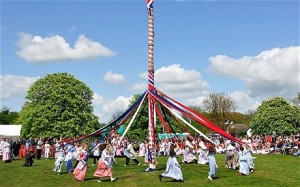 It is almost May, which for many of us mountain dwellers means packing away the winter gear and time to get a mud-season break while we plan our summer adventures. For thousands of years, though, May has been a time to rejoice in the return of summer, and the comfort and fruitfulness nature provides during summertime. Like many modern holidays, May Day has its origins in multiple ancient religious traditions, though it is now celebrated as a secular holiday in many nations.
It is almost May, which for many of us mountain dwellers means packing away the winter gear and time to get a mud-season break while we plan our summer adventures. For thousands of years, though, May has been a time to rejoice in the return of summer, and the comfort and fruitfulness nature provides during summertime. Like many modern holidays, May Day has its origins in multiple ancient religious traditions, though it is now celebrated as a secular holiday in many nations.
The Druids of the British Isles celebrated May 1 as the day that divided the year in half, during which they would set cleansing fires to represent the lengthening days and warmth of the sun. The Romans also celebrated Floralia, a festival to celebrate the goddess Flora, for six days around this time of year. Flora is the goddess of flowers and fertility, associating her with spring. When the Romans conquered the British Isles, their traditions came to intermingle with the Druids’ and created many of the rituals still celebrated today on May Day.
The most notable May Day tradition is the maypole, the tall wooden structure around which maypole dances take place. The symbolism of the maypole has long been debated, but may be related to yet another ancient religion. Under Norse paganism, the entire universe is contained within a tree called Yggdrasil, which may have been represented by a large wooden structure during holidays and adopted by other cultures. Others speculate that the maypole simply represents trees and the growth of new leaves in the springtime.
Since at least the 14th century, May Day participants have festooned the maypoles with garlands of flowers and leaves, and performed music and dances around the structure. Every village in the British Isles would set up their own maypole each year, competing for the tallest and grandest structure. The competition could get out of hand, however, sometimes leading to violence when people stole their neighboring village’s maypole, or when the upper class had trees removed illegally from their estates.
During the Protestant Reformation, May Day celebrations in Great Britain were banned for idolatry, and most maypoles were destroyed. In Nathaniel Hawthorn’s short story “The May-Pole of Merry Mount,” he writes a fictional account of Puritans coming to chop down a maypole in a 1630’s New England village. Around this time, most Scandinavian cultures began using maypoles during their summer solstice celebrations instead of May Day. After about a hundred years, maypoles were again tolerated in most European and American regions. New traditions emerged with May Day’s revival, with some villages attaching ribbons to the top of the maypole rather than flowers, and performing elaborate dances while decorating the structure.
Other May Day traditions that have evolved over the centuries include the gifting of a May basket. Celebrated still even in some regions of the United States, children anonymously leave baskets of flowers or sweets on their neighbors’ doorsteps, a nice version of “Ding Dong Ditch.” Some celebrations crown a “May Queen,” a young woman to preside over May Day parades.
While May Day is a holiday that has strongly waned over the years, especially in the United States, many towns and nature centers host popular May Day events to this day. Americans also continue to create their own modern spring festivals, yet the maypole still has an appeal that tells us that it may never disappear. Whatever your traditions are, feel free to use May Day as an excuse to get outside and celebrate nature!
Hannah Irwin is the Community Programs Coordinator at Walking Mountains Science Center. One of her most memorable moments from preschool is skipping around a maypole with her friends.









